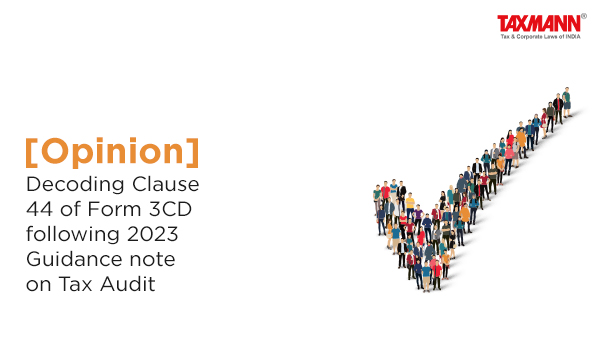[Opinion] Decoding Clause 44 of Form 3CD following 2023 Guidance note on Tax Audit
- Blog|News|Income Tax|
- 2 Min Read
- By Taxmann
- |
- Last Updated on 22 September, 2023

CA V. Sudharsan – [2023] 154 taxmann.com 409 (Article)
Clause 44 made its debut as a new addition to Form 3CD of the Tax Audit Report (TAR) starting from the Assessment Year 2022-23. It is worth noting that although this clause was initially introduced through a notification dated July 20, 2018, its enforcement was consistently postponed each year through a series of circulars. The final circular addressing this matter was Circular No. 05/2021, dated March 25, 2021, which extended the deadline for its implementation until March 31, 2022. Consequently, any Tax Audit Report in Form 3CD submitted after March 31, 2022, must adhere to the requirements outlined in clause 44.
Since the introduction of this clause in the Tax Audit Report, tax professionals have expressed significant concerns and challenges related to gathering the necessary information from the assessees’ accounting records. Additionally, there has been ongoing uncertainty surrounding the interpretation of the information presented in this clause, particularly from the perspective of tax authorities.
This article endeavors to offer valuable insights into Clause 44, taking into consideration the latest Revised Guidance Note issued by the Institute of Chartered Accountants of India (ICAI) [Please see: “Guidance Note on Tax Audit under Section 44AB of the Income-tax Act, 1961 (Revised 2023) – Ninth Edition 2023″]. Additionally, the author delves into a discussion about the risks associated with and potential mitigating strategies for providing information within this clause.
Consolidated or Expenditure-wise information
The primary question that arises is whether to provide the figures in a consolidated manner or furnish expenditure-wise details. In this context, Para 82.1 of the Guidance Note provides clarity by stating that the information required under this clause should be presented in a consolidated fashion, and there is no requirement to provide figures on an expenditure head-wise or nature-wise basis.
However, the Guidance Note suggests having a reconciliation statement in the following manner:
| Description | Amount (Rs) |
| Total value of expenditure in P&L for the year | xxxx |
| Add: Total value capital expenditure not included in P&L for the year | xxxx |
| Less: Total value of non-cash charges considered as expenditure | xxxx |
| Less: Total value of expenditure excluded for being transactions in securities and transaction in money | xxxx |
| Less: Total value of expenditure excluded by virtue of Schedule III to the CGST Act 2017. | xxxx |
| Balance being value of expenditure for clause 44 | xxxx |
[Details of all deductions and additions must be maintained for each sub-entity (GSTIN wise) of the legal entity]
Click Here To Read The Full Article
Disclaimer: The content/information published on the website is only for general information of the user and shall not be construed as legal advice. While the Taxmann has exercised reasonable efforts to ensure the veracity of information/content published, Taxmann shall be under no liability in any manner whatsoever for incorrect information, if any.

Taxmann Publications has a dedicated in-house Research & Editorial Team. This team consists of a team of Chartered Accountants, Company Secretaries, and Lawyers. This team works under the guidance and supervision of editor-in-chief Mr Rakesh Bhargava.
The Research and Editorial Team is responsible for developing reliable and accurate content for the readers. The team follows the six-sigma approach to achieve the benchmark of zero error in its publications and research platforms. The team ensures that the following publication guidelines are thoroughly followed while developing the content:
- The statutory material is obtained only from the authorized and reliable sources
- All the latest developments in the judicial and legislative fields are covered
- Prepare the analytical write-ups on current, controversial, and important issues to help the readers to understand the concept and its implications
- Every content published by Taxmann is complete, accurate and lucid
- All evidence-based statements are supported with proper reference to Section, Circular No., Notification No. or citations
- The golden rules of grammar, style and consistency are thoroughly followed
- Font and size that’s easy to read and remain consistent across all imprint and digital publications are applied



 CA | CS | CMA
CA | CS | CMA
